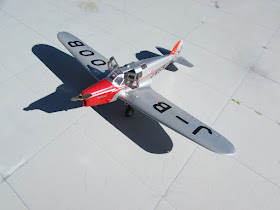The lovely, serene and pleasant lines of the British Aircraft (formerly British Klemm) Eagle 2 are fairly replicated by this little kit of a "cottage" manufacturer that has consistently evolved through the years.
(The step-by-step building post is here:
https://wingsofintent.blogspot.com/2021/05/b-eagle-2-172nd-dekno-resin.html
I departed from the kit decals offering and decided to represent a 1935 machine used for a long-distance England-Japan flight, piloted by Katsutaro Ano (ト阿野勝太郎), named "Seikai". Sources translate it as Blue Sea, but online translators also posit "Right Answer", the right thing. The flight was not without trouble, and ended up taking almost 100 days. The plane had originally the British reg. G-ADFB, but was eventually registered in Japan as J-BOOB. I am using for this model a set from Arctic Decals, that in fact has the two registrations, British and Japanese, for the modeler to choose.
Interesting links:
https://paperspast.natlib.govt.nz/newspapers/THD19350629.2.98.1
http://publicdomainphotonew.blog.fc2.com/blog-entry-18.html
I have also found some information about this plane on the Arawasi blog, an interesting source for Japanese plane lovers. A link to their site is on the side bar.
My first experience (Note: this kit was build first but posted after the Laird Super Solution from the same manufacturer) with a Dekno kit can be deemed as fair overall, although still with some nitpickings.
The positives:
1) Very attractive range of racers and desirable civil types in general
2) Presence of functional and practical locking devices throughout, and fair engineering that works well (a scarce commodity in this segment of the industry that some times presents the modeler with awful butt joints and imprecise and coarse moldings)
3) Fair interior and exterior detail
4) Good decals (I only used the inst. panel, which went on perfectly)
5) No bubbles, pinholes or short pours
6) Very good fit of most parts
7) Clean casts with sharply-defined volumes, not the resin blobs we sometimes encounter in small manufacturers
8) The trailing edges of the flying surfaces are very thin and therefore realistic
The nitpickings:
1) In my sample I found in some areas a faintly "ridged" surface effect, product most likely from the masters being 3D-printed, and the "ridges" not sufficiently smoothed out during refining of the masters. This is only visible on close inspection, and looks sometimes like the ridges produced by fingerprints (although that's not the case here)
2) Clear parts in resin that are not the best in clarity and optical quality.
3) Slight deformation of the major parts in my sample, like fuselage sides and wings, but correctable with hot water and careful manipulation. We know this happens sometimes with resin kits.
I felt curious enough about Dekno kits that I bought a Laird Super Solution, that is here:
https://wingsofintent.blogspot.com/2021/08/laird-super-solution-172nd-dekno-resin.html
Thanks to the generous friend (you know who you are) who very kindly gifted this kit to me, which gave me the opportunity of a hands-on experience with this brand. My thanks to Arctic Decals for the production of the specially-commissioned set; their consistent excellent quality always enhances the builds.





























No comments:
Post a Comment